To build a town dedicated to a saint, to build a tower in memory of his elephant, and to transfer his capital to this place till his reign, was the glory of Emperor Akbar.
During my recent visit to Agra, I spent an entire day exploring Fatehpur Sikri, a town established by Akbar. I took refuge in Agra and the next morning I left for Fatehpur Sikri from Agra.
Let me tell you that Fatehpur Sikri was the first planned town to be constructed in the Mughal period. Fatehpur is made from two words. Fateh means “victory” and Pur means “city” and there used to be a village named Sikri here, due to which it was named Fatehpur Sikri.
This article is a travel guide for Fatehpur Sikri. We will tell you about every building inside the Fatehpur Sikri Fort and also what to do, how to get there, and what to expect there.
Let’s roll.
- Virtual Tour
- Why was Akbar so kind?
- Thicken Your Skin Before You Go
- Buland Darwaza: A Sign of Akbar's Victory
- Sheikh Salim Chishti Dargah
- Entrance to Fatehpur Sikri Fort
- Jodha Bai's Palace
- Harmasara (stables) and Birbal's Palace
- Mary's House
- Panchmahal – Palace of Five-Storeys
- Diwan-e-Khas
- Astrologer's Place and the Treasure House
- Turkish Sultana's House and Girl's School
- Anoop Pond
- Diwan Khan-A-Khas and Khwabgah
- Diwan-e-Aam
- Museum, Factory, and Naubatkhana
- Practical Travel Tips
- Ticket Rate and Timings
- How to reach?
- Conclusion
Virtual Tour
Why was Akbar so kind?
There was a question ticking in my mind and perhaps you might be wondering it too, that why Akbar built a grand city at the living place of a saint?
Sheikh Salim Chishti was a famous Sufi saint during the reign of Akbar, whose magical splendor permeated the minds of the people. He lived in a small village named Sikri, near Agra.
It was the time when Mughal emperor Akbar continued to expand his empire with victory over victory. He has every blessing except the fortune of having a child. Due to this, he often felt disturbed inside.
Finally, with the blessings of Sheikh Salim Chishti, the wish of his child was fulfilled and he was blessed with a boy. He named his son Salim after this saint, who later became famous as Jahangir.
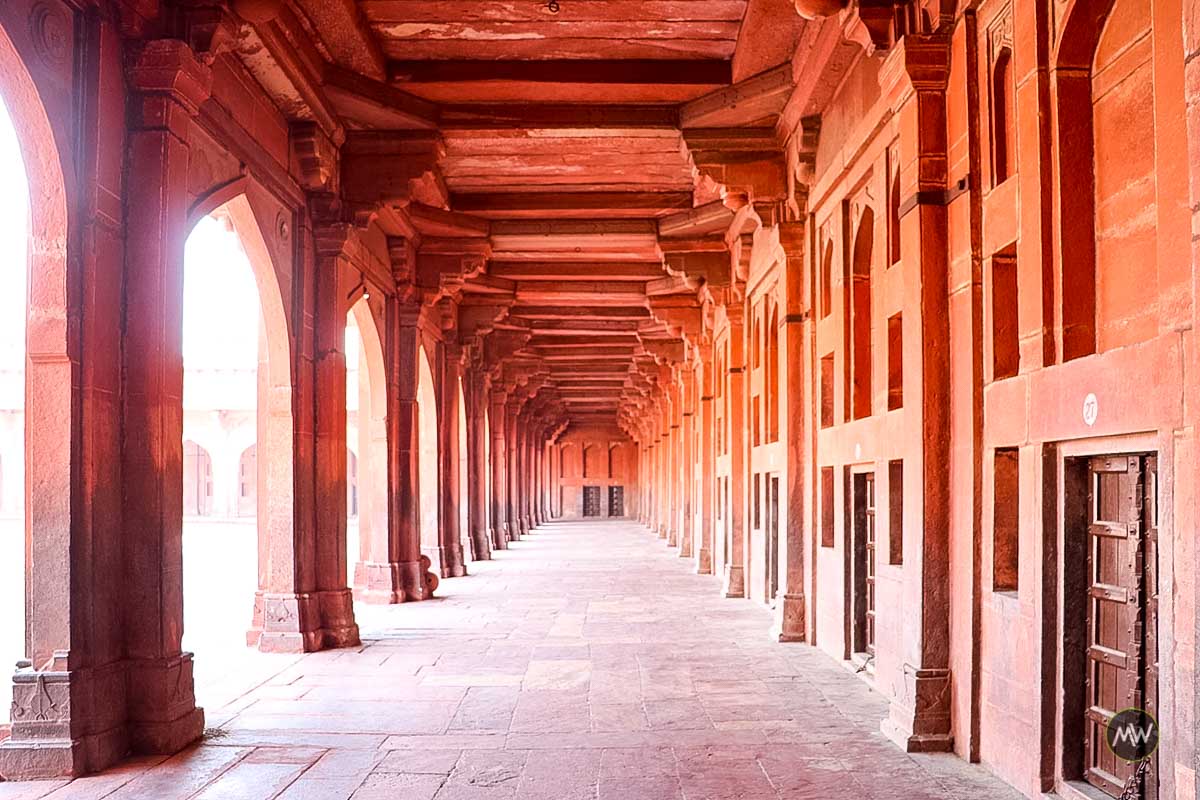
Finding his bag full of happiness, Akbar adored a modest village like Sikri and converted it into a shining city. Not only this, the dargah of that great saint was also built with great admiration.
Thicken Your Skin Before You Go
A measly journey of approximately 40 km on the city bus took us from Idgah of Agra to Fatehpur Sikri bus station. Descending from the bus, we asked the conductor for the path to the Buland Darwaza and he pointed to a narrow steep path behind.
“Oh wow, Buland Darwaza is just above the bus station,” I said looking at the door.
By the way, he gave another suggestion that we should take no guide and take special care of our belongings. By the way, I had already read about it in many articles (during the research) that people here force you to get a guide and once, even attacked a foreign tourist. After reading all this, the advice of the conductor created a state of fear in the mind.
A short climb and the skyscraper was in front of my eyes. So huge that I had to lift up my neck to see its peak – this laziness. Neither any policeman nor any tourism department board, just goats, and some pets were all that was wandering on and around the staircase of Buland Darwaza.
The thing that surprised me the most was the presence of people sitting on the stairs. For a moment, I felt that everybody is a tourist but no these were probably locals. As I was standing in front, a person suddenly came to me and started telling the history of the Buland Darwaza. I exclaimed with exuberance, “Brother! Take a breath. You are going to tell everything without even asking?”
The reply was received, “I am from the trust, will give you complete information for fifty rupees.”
I said, “I have come here after studying about it, you do not need to suffer.”
“There is some no information board inside, which you will read… well, let’s finish the deal in twenty rupees for two people,” he asserted.
The person even climbed up some stairs with his continuous pitch. I folded my hands and politely refused. After climbing a few stairs, another person came and started explaining the itsy-bitsy of the monument.
I said, “Well, tell me when was it built?” He said, “In 1610.”
Folding my hands, I said, “Sir you are wrong.”
Vipin said, “Brother, we are travel writers and if you tell us wrong, we will write the same. It would be better to let us explore alone.”
Hearing this, he retreated his legs.
Advice: Near Buland Darwaza, some people will introduce you by telling themselves to be a guide from the trust and will promise to give complete information in exchange for some money. Some will even take an aggressive stance. But make sure you keep on ignoring, refusing everything calmly. If you want guides, ask at the ticket counter.
Buland Darwaza: A Sign of Akbar’s Victory
Standing under the grandeur Buland Darwaza, I was feeling like an ant – jaw-dropped and unable to utter a single word.
Being at a height, the whole town was clearly visible from the opposite side of Buland Darwaza.
Not only this, it has the reputation of being the world’s highest gateway.
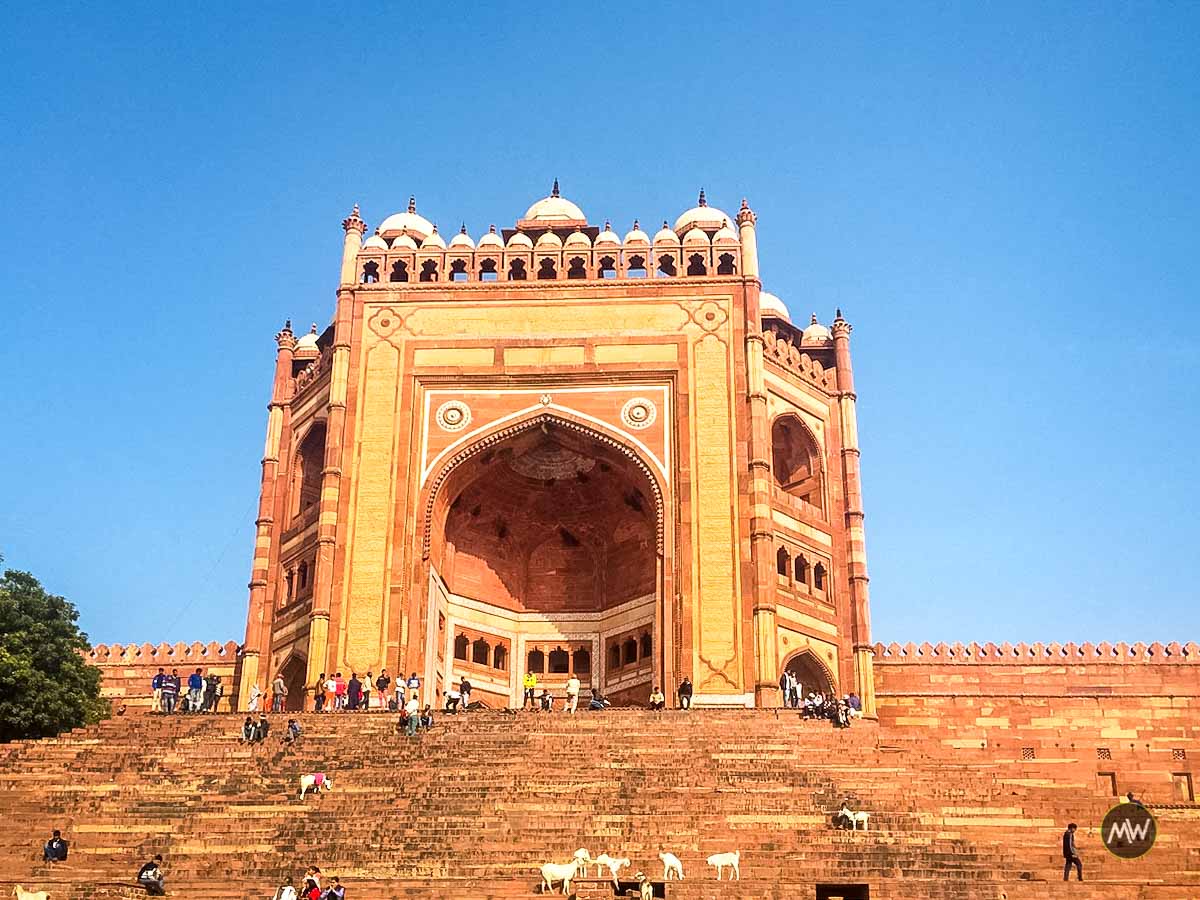
The reason behind the construction was to commemorate Akbar’s victory over Gujarat. It was built in 1602 and is 54 meters long and 35 meters wide and serves as an entrance to Jami Masjid (mosque).
Built of red sandstone, white marble has been used to decorate this building. It is an excellent specimen of Mughal architecture. It also shows the unity of all the religions of Akbar.
When I looked closely, I found that the chhatris (top) are built in the Rajput style. There are also inscribed verses from the Holy Quran in Persian and on the upper part of the door, a few lines relating to the Lord Jesus was written. It was as follows, “Jesus son of Mary said: This world is like a bridge, pass through it. But don’t build your house on it. He who hopes for one day can have hope forever, while the world only lasts for a short time, so spend your time in prayer, except that everything is invisible.”
That is, man’s life is temporary, we have to leave the world one day, so do not consider this world to be your permanent residence and spend your time in devotion to God.
Sheikh Salim Chishti Dargah
I put my shoes near the entrance and went inside. The first thing my eyes fell on was a white marble building surrounded by the red sandstones’ architecture on each side. Just as seen in the pictures – this is the graveyard of Sheikh Salim Chishti.
By the grace of this saint, Emperor Akbar was blessed with a son. He was a great religious teacher after whose death Akbar built this dargah, where today thousands of people tie the thread of vow.
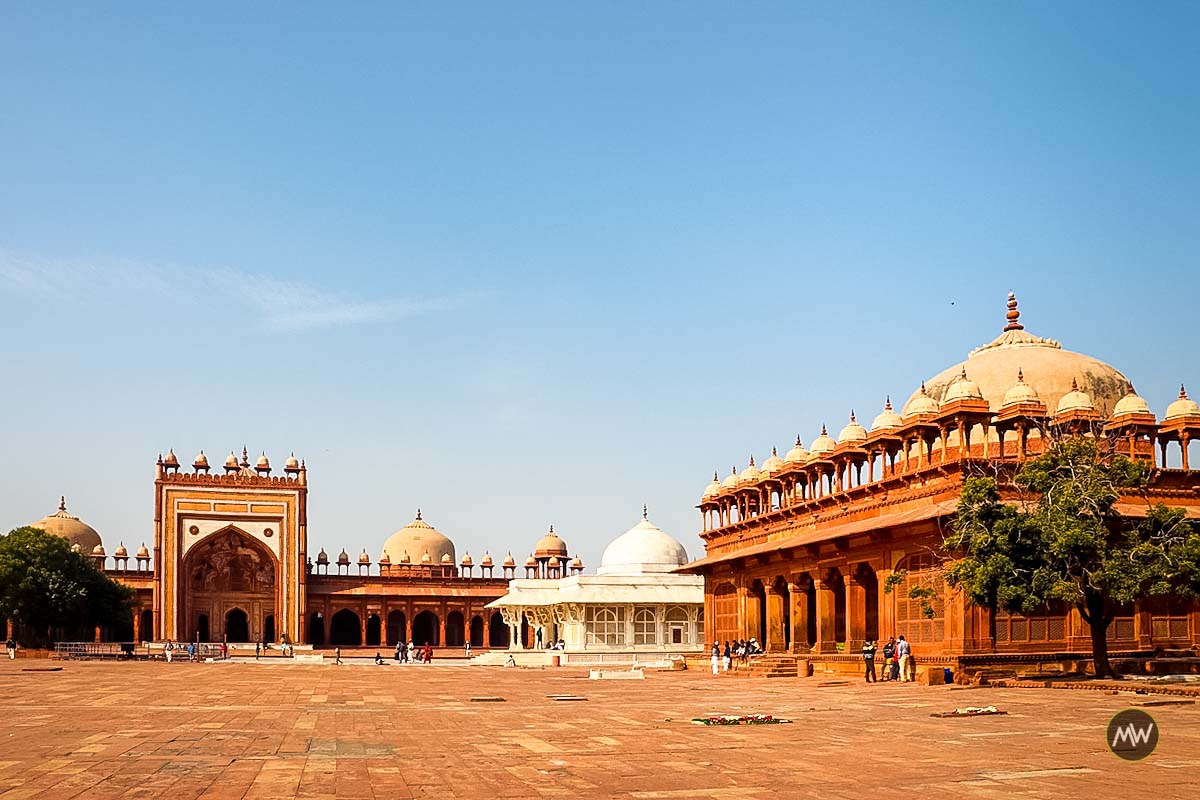
Just opposite the dargah is the Hauz tank or holy water.
After washing my hands, I entered inside and took a circumambulation while observing the intricate carvings on white marbles.
In the center, lies the tomb of Saint Salim Chishti. This dargah reminds me of the Dargah of Khwaja Muinuddin Chishti of Ajmer.
When I came out, some people were singing qawwali soaked in the melody of Sufi music. I also sat with them and sang a few lines. On the right side of the dargah are some other tombs which belong to the family of Salim Chishti Saheb. Situated next to it was the Jami Masjid, in whose premises some people were sunbathing.
After spending some moments of silence, I took my shoes from the entrance and exited through another gate (to the right of the Buland Darwaza) which is called “Badshahi Darwaza“. This was the same door that emperor Akbar used to enter Jami Masjid.
Entrance to Fatehpur Sikri Fort
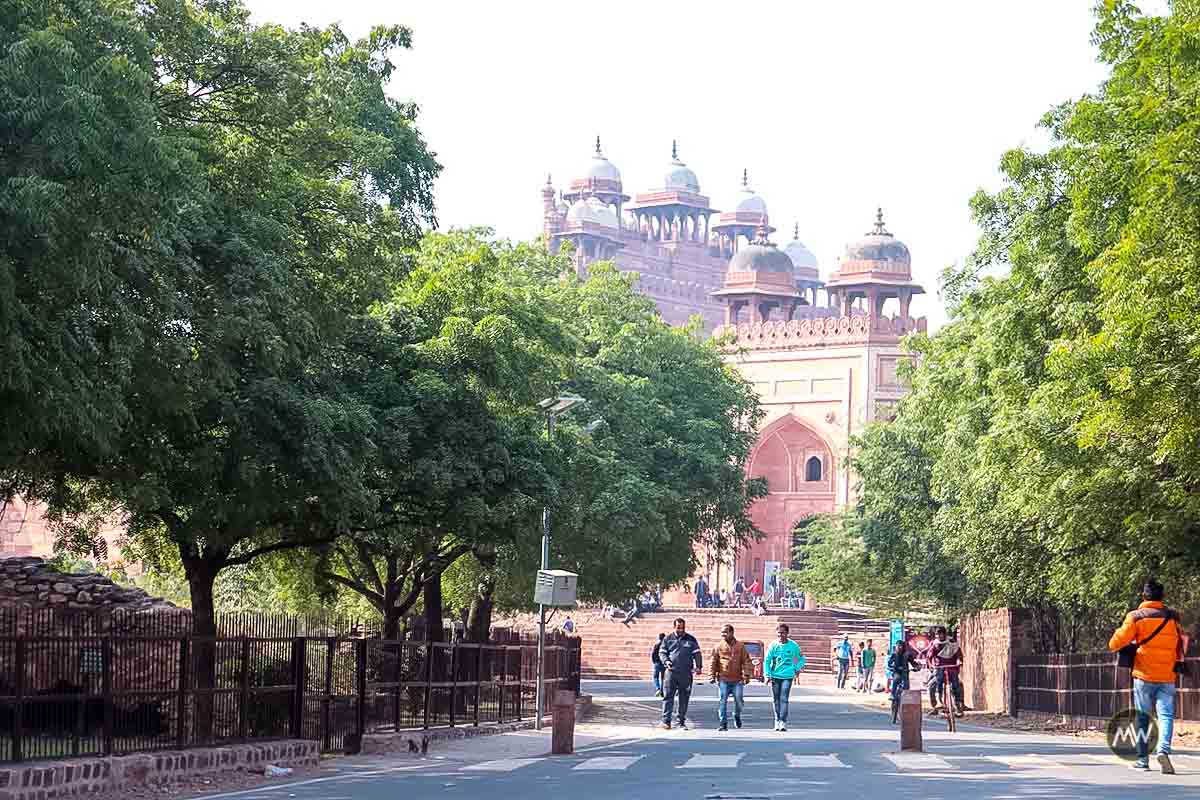
We asked the security guard at the gate, “Where’s the fort?” He showed us the direction and after a short 2 minutes walk, we reached the fort.
By the time Vipin booked the tickets online, I started reading information about the palace inscribed on stone. Then an elderly man came near and showed us a badge of ASI (Archaeological Survey of India) on his shirt pocket and said, “I am the official guide of ASI, will give you a tour of the entire fort for ₹450.” When we refused politely, he said again, “Well, okay give ₹200 rupees, son.” I again refused and went ahead.
As you enter there are two directions you can go, one to “Stables” and the other to “Jodha Bai’s Palace“. We showed more interest in seeing the palace first. It doesn’t matter what you choose, both converge inside.
It could be a good idea to take some rest under the shade of trees here as you won’t find that inside. We did so.
Now our first stop was…
Jodha Bai’s Palace
According to the inscription at the entrance of the palace, it was probably built between 1570–1574 and was the main harem of Akbar, mistakenly known as Jodha Bai Mahal. Anyway, I entered and saw a plant in the middle. Somebody said that there used to be a Tulsi plant here.
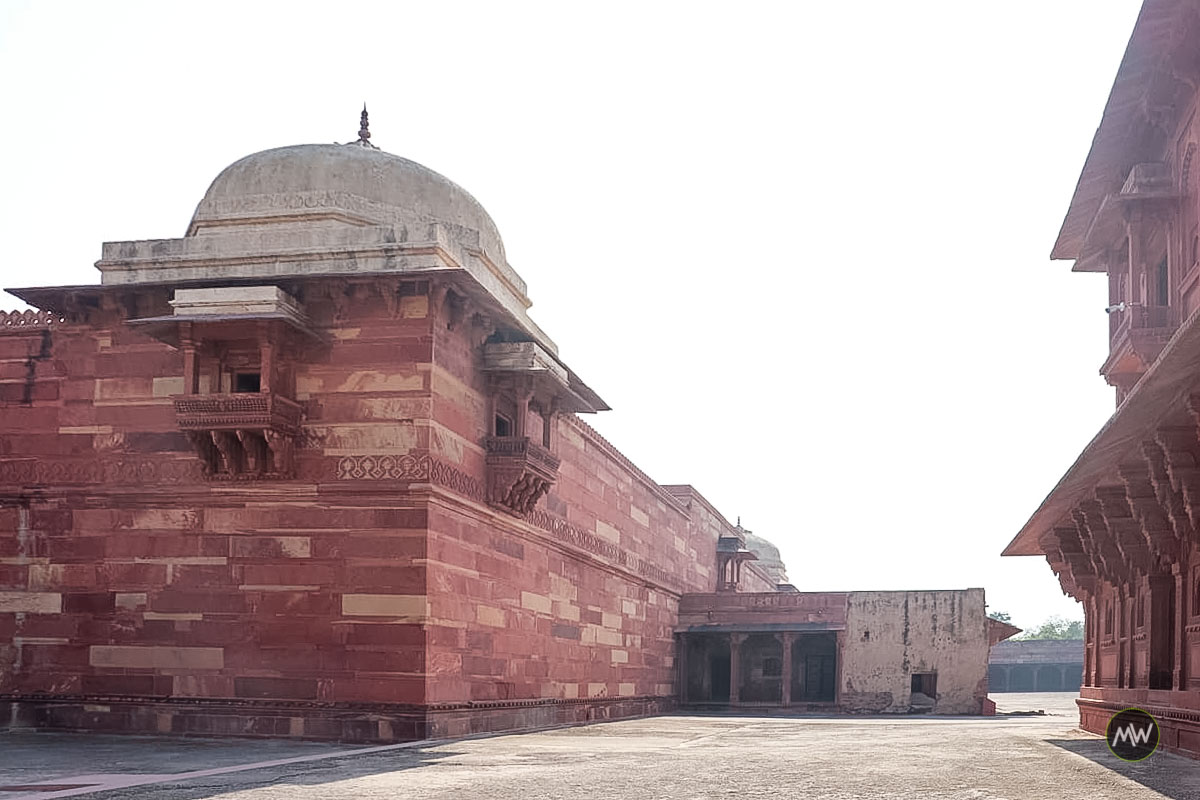
Surrounded on all three sides, the palace has a square courtyard plus some rooms. I looked west on a verandah which was based on pillars. There were small drawers on the walls of this room where there were idols of God and a platform in the middle used to hold the statue of the main deity.
The entire palace is built in Rajput style. This shows that Akbar had given the freedom to Jodha Bai to live life and worship. Jodha Bai probably resided here with her maids. On the left, a documentary film was going on in which no tourists showed interest, but I watched it for some time anyway.
Harmasara (stables) and Birbal’s Palace
Jodha Bai’s kitchen where she used to cook food for Akbar was right near the taps of drinking water. Going forward, an open space appeared and a small but attractive building stood at the entrance hallway.
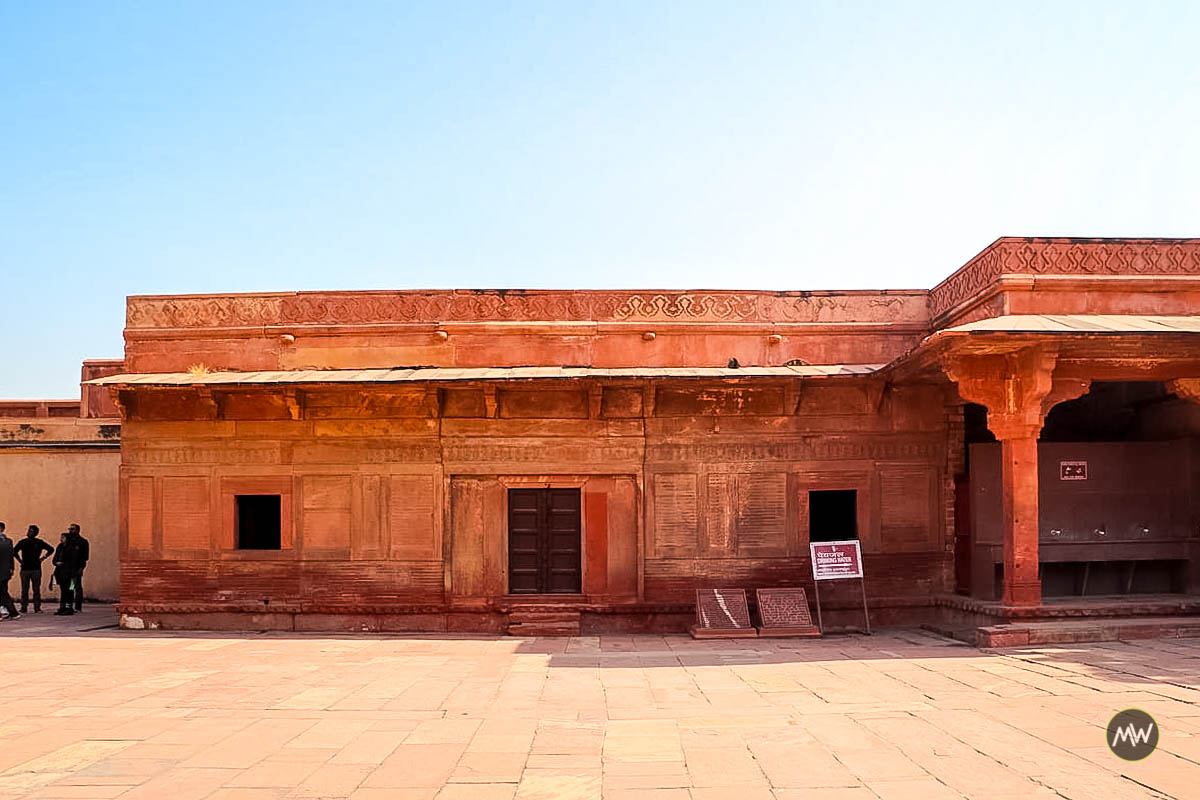
Vipin went down to click pics and I started reading inscriptions.
Two inscriptions indicating that it was a dwelling place for elephants, horses, and camels. When we entered one of the stable, we found a large hall-like place accessible through a small door which may have been used to protect animals from rain and bad weather, or for the personnel engaged in animal care.
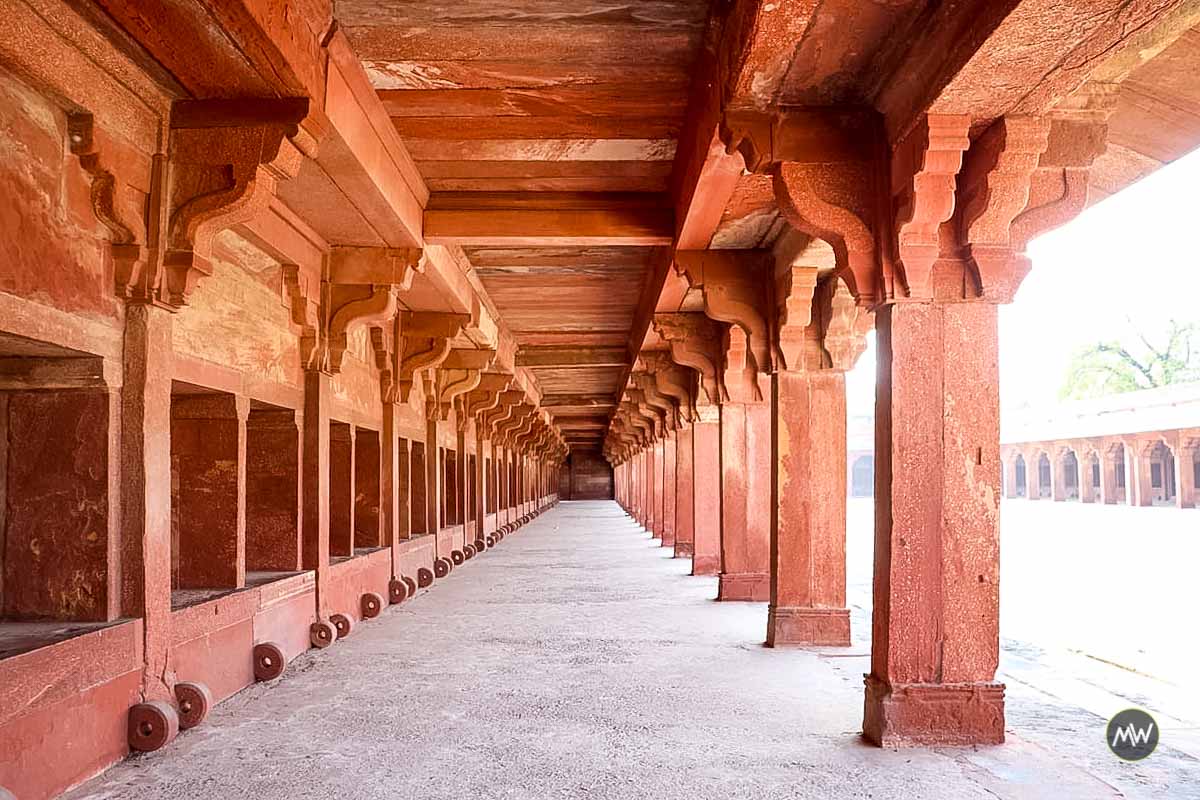
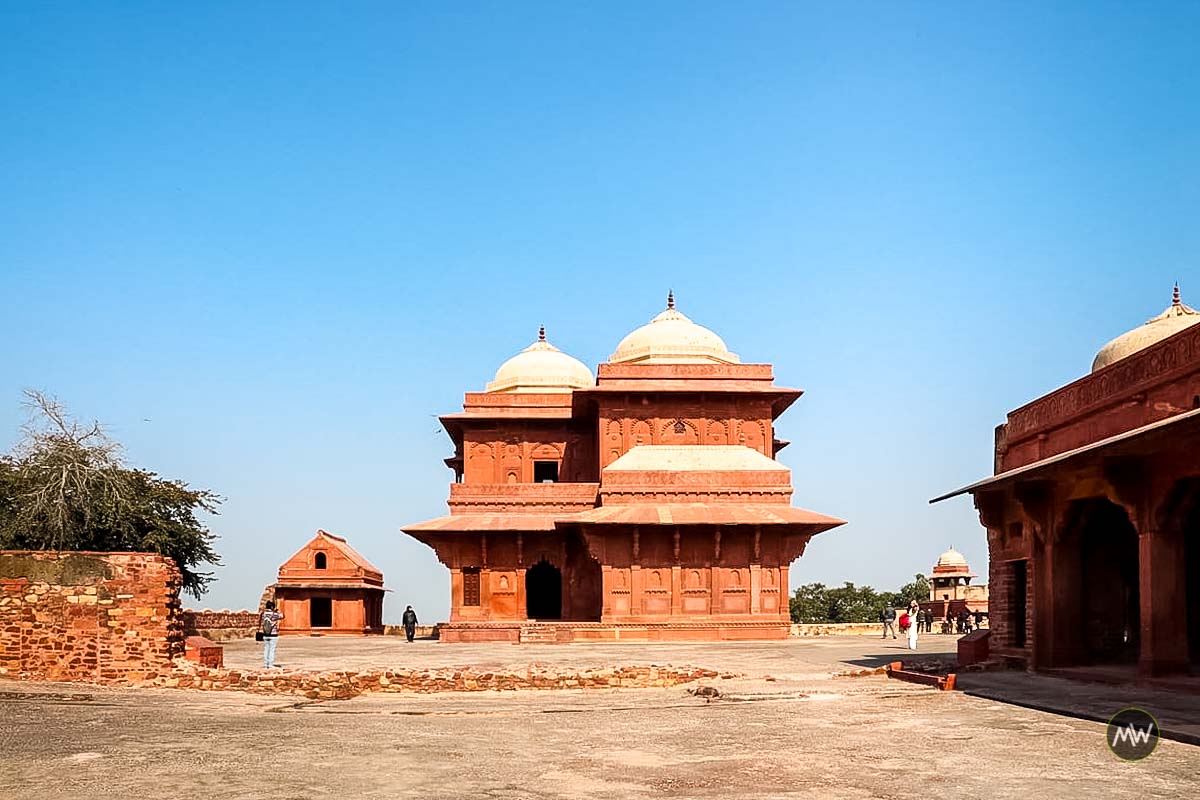
The attractive build that stood in the middle was Birbal’s palace, a part of Harmarasara itself. Akbar’s other two Begum Rukaiya Begum and Salima Sultana Begum are said to have resided here.
The double-storeyed building has four rooms at the bottom of this building and two rooms at the top. The fine carvings and the structure of the arches on the upper part look attractive.
Mary’s House
This building is very close to Jodha Bai’s kitchen. You can even explore it after Jodha Bai Mahal.
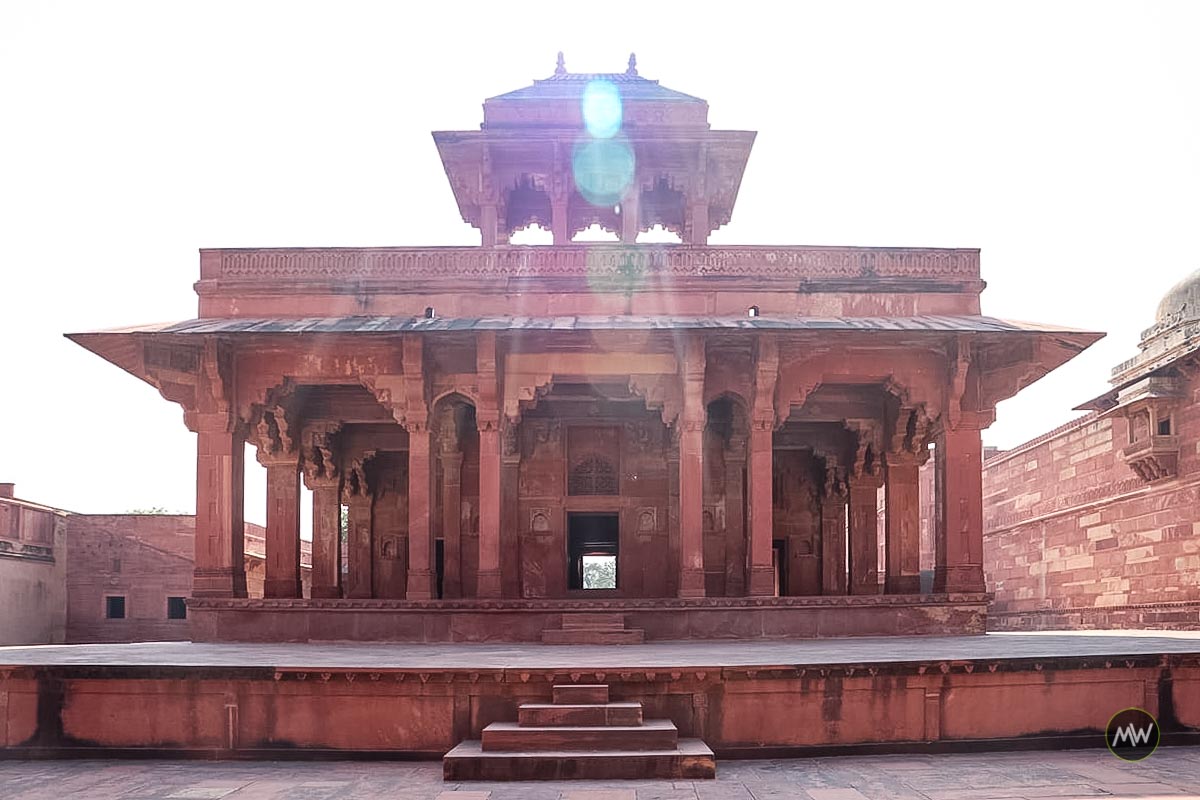
We came back and Vipin asked while taking the photo, “What is this?” “House of Mary.” I said. This place is also known as Swarna Makan or Golden House because it is full of pictures.
But I liked some things, carvings of Shri Ram, Hanuman as well as of swans, horses, and elephants. The walls have also been painted with very good artistry. At some places, verses are also written in Persian language.
Panchmahal – Palace of Five-Storeys
This is what I was waiting for.
Panchmahal means palace of five floors. This entire palace is based on a total of 176 pillars with 84, 56, 20, 12, 4 pillars from the first to the fifth floor respectively which appear in descending order from bottom to top. It is also called Badgir.
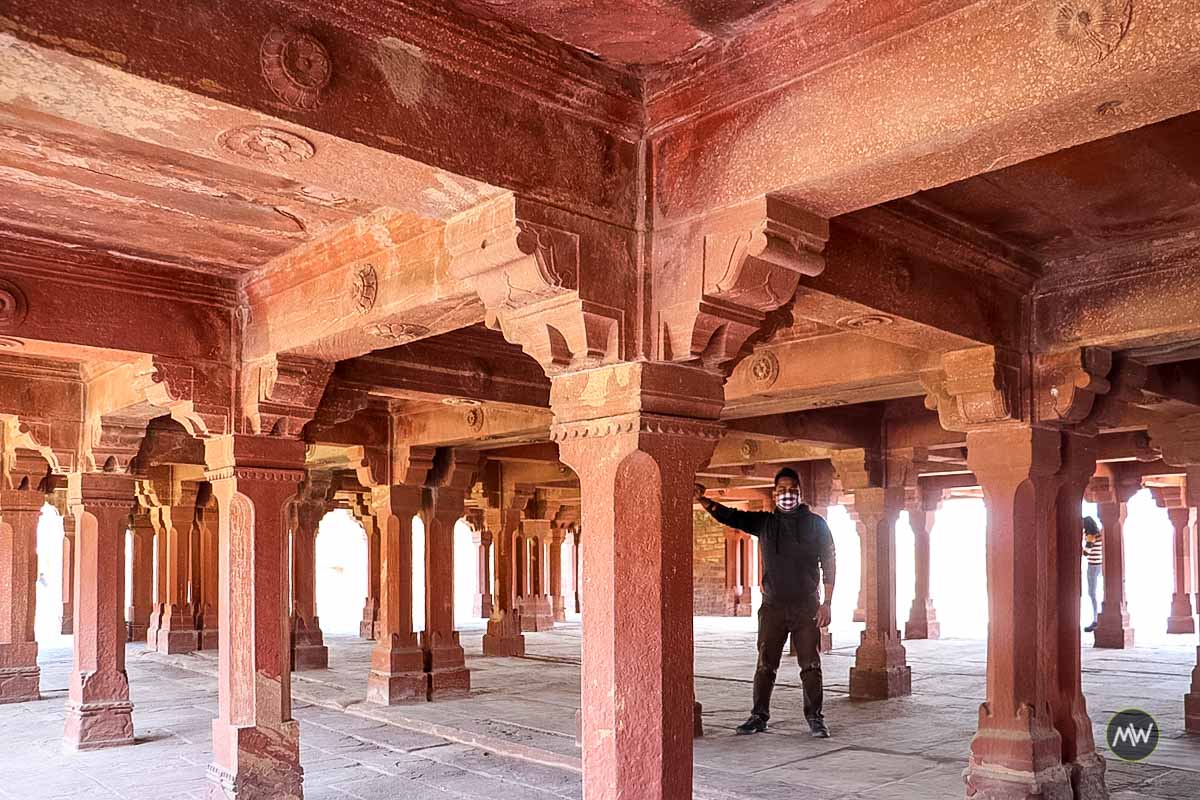
I went under the first floor and was stunned to see the ordered combination of columns. This palace used for entertainment and spend some precious time. Emperor Akbar used to enjoy the cool breeze in the evening and the moonlight at night. Its third floor is connected to the harem from where the Begums and the royal women used to come up here, avoiding the eyes of the common people. There is a pond just in front of it, which I will explain later.
Diwan-e-Khas
I remember during the school days, I used to read about Dewan-e-Khas and Dewan-e-Aam in the history books and imagine their shape and luxury. Now when I see them with my own eyes, it feels different.
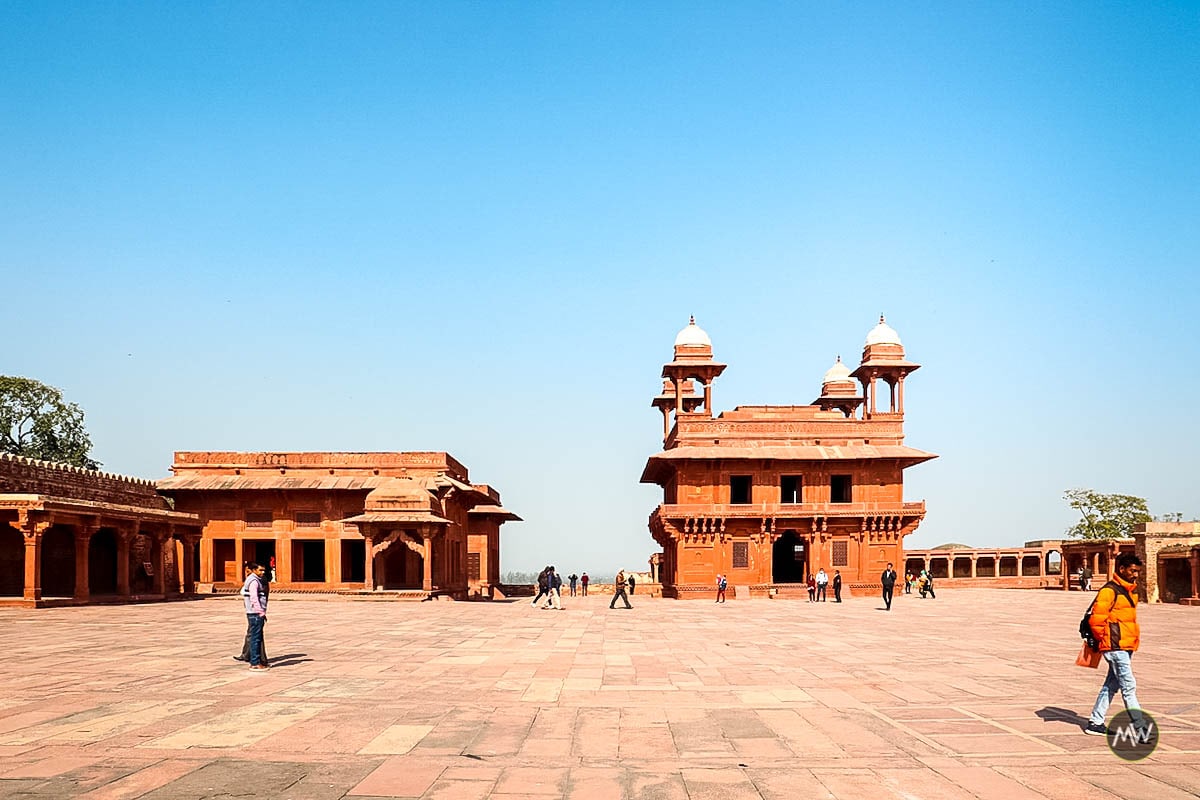
Some say that it is a pillar of justice, and some call it a worship place. But as I have read it was used by Akbar for special talks and decisions with his wazirs.
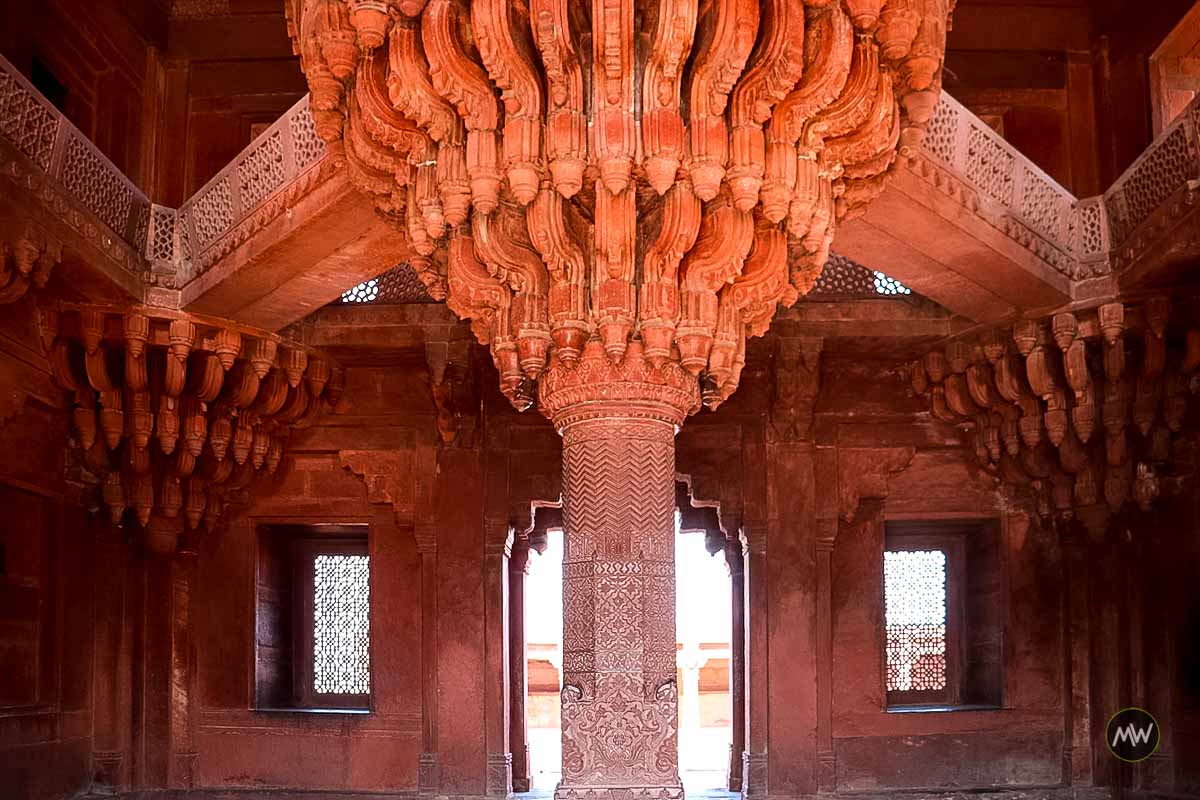
As soon as entering, a column with very breathtaking artwork was standing in the center. Akbar used to sit on his throne just above this pillar. Four wazirs or advisors used to sit on its four corners. Its intricacy and details are enough to mesmerize you at first glance.
Astrologer’s Place and the Treasure House
We saw a board with “Astrologer’s Seat” inscribed on it. Perhaps astrologers used to sit here in those days. A building on the left side, which is called Ankh Michouli, was used to be a state treasury where gold and silver were stored.
After going behind it, a strange pillar-shaped figure appeared at a far end in the green fields down below. Vipin told that this is the “Hiran tower”.
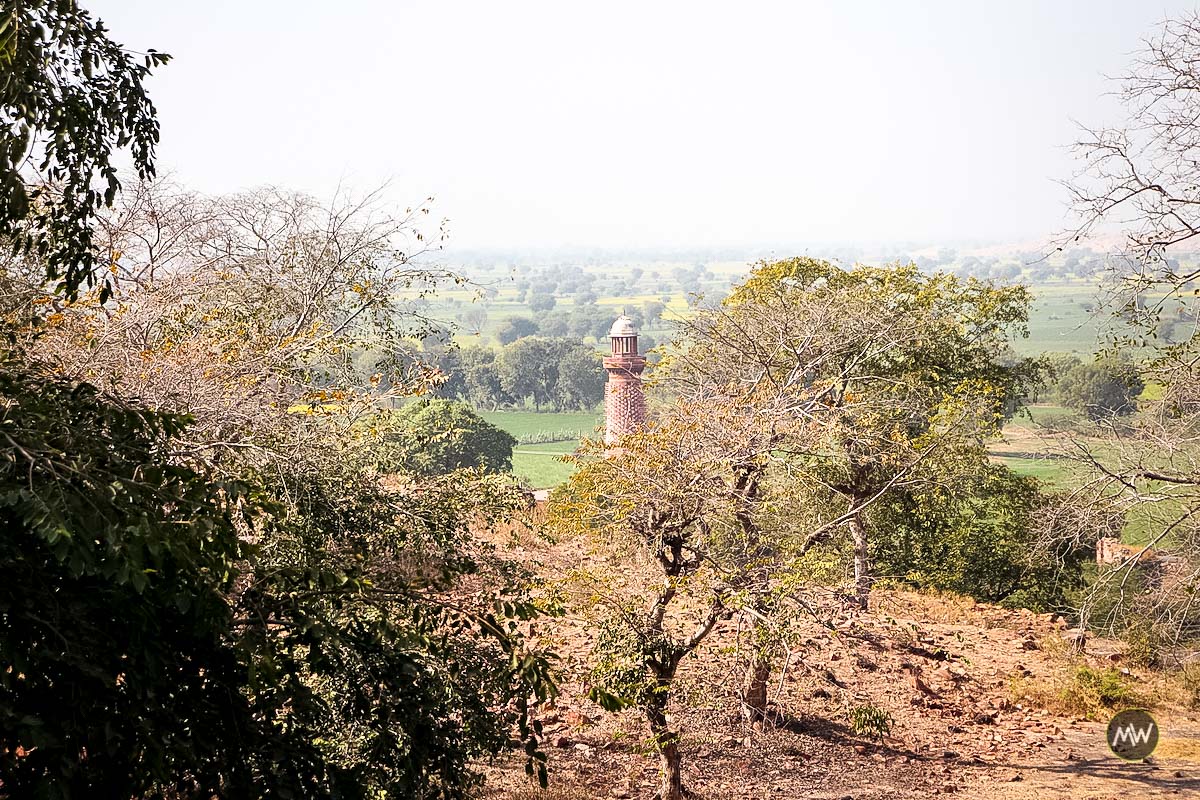
Folklores are that the Hiran tower got its name after Jehangir, the son of Akbar, built a deer sanctuary around it (deer means Hiran in Hindi).
The minaret is also known by the name of Elephant tower. People believe that it was built by Akbar in memory of his beloved pet elephant named Hiran (Akbar must have been a very emotional and sociable person).
There are elephant tusks protruding from the structure, so it could also be the reason for the name.
Turkish Sultana’s House and Girl’s School
In terms of carvings, it is perfectly safe to say that it is the best building of the entire fort complex. It made my eyes glow.
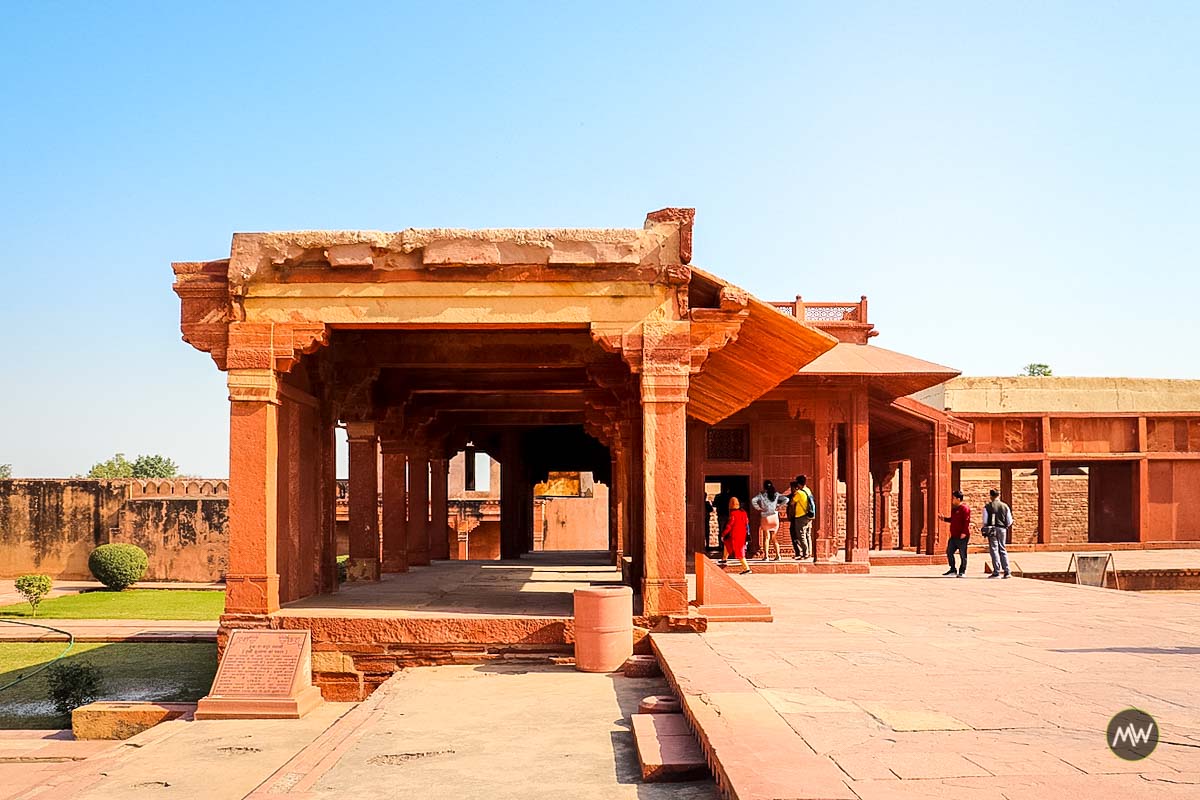
The geometric carvings along with the flowers and leaves on the walls of its verandah are just soothing. A similar carving has been done in the rooms inside.
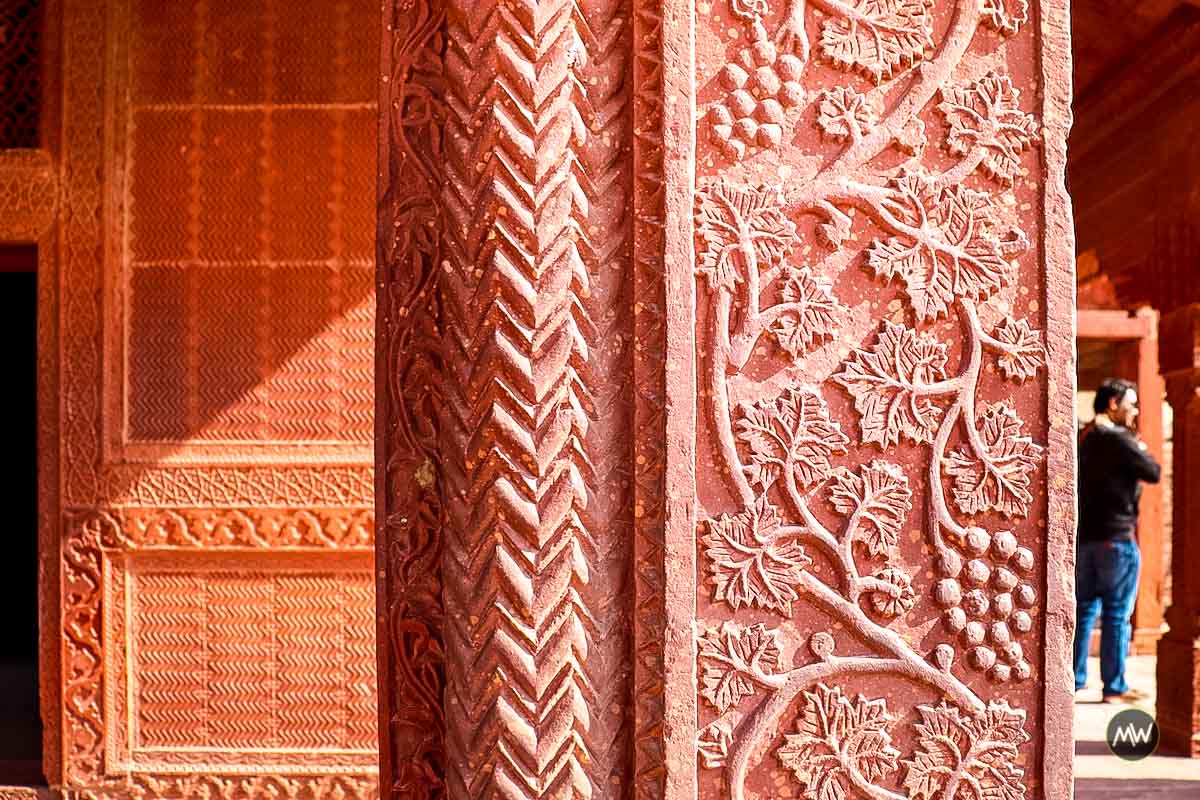
It is connected to another building by a verandah and this building was a girls’ seminary/school where education was provided.
Anoop Pond
This pond, 30 meters square, is submerged from all sides, and located in the middle of it is a jagged platform. There are four ways to reach the platform.
We have all read and heard about the great musician Tansen, how clouds used to burst and spices would burn when he sang. I do not know how true this thing is, but this place was used for festivals and cultural programs.
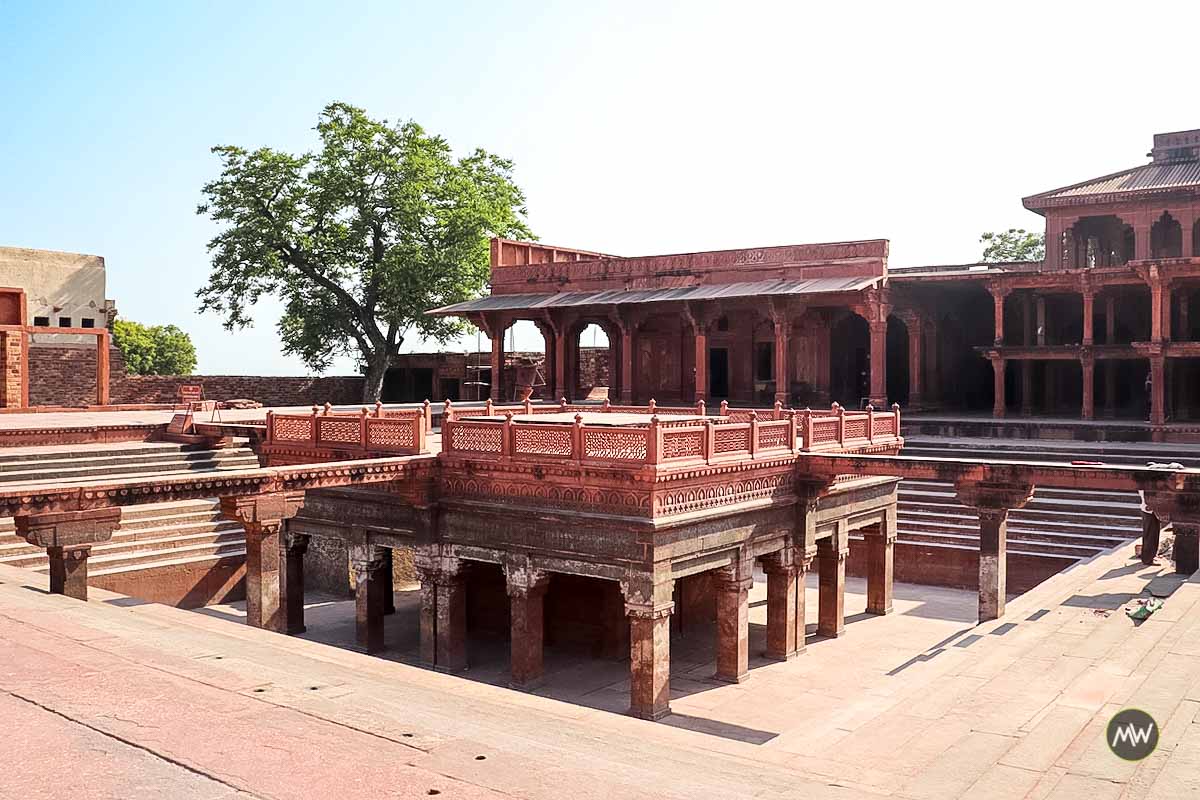
Tansen also used to sing raga at this place. Akbar used to enjoy music, sitting on the top floor of the Panchmahal with his Begums. I have read and heard many legends related to Akbar and Tansen. Now it is indeed a privilege to visit this place.
Diwan Khan-A-Khas and Khwabgah
How long have I been telling the entire Fatehpur Sikri fort builder? Now is also the time to know where the Mughal emperor lived.
Khwabgah is the place where Mughal emperor Akbar used to live. There were rooms at the bottom and an open airy veranda above. This place was called the Khwabgah.
Probably there used to be a library too which and rooms were equipped with murals, books, and Persian verses. There was also a jharokha through which Akbar used to see his people daily.
Diwan-e-Aam
“Brother, everything is done but where is Diwan-e-Aam?”, Vipin said.
I quickly started looking at the pic of the map I took at the entrance. It turned out that Diwan-e-Aam is near the exit.
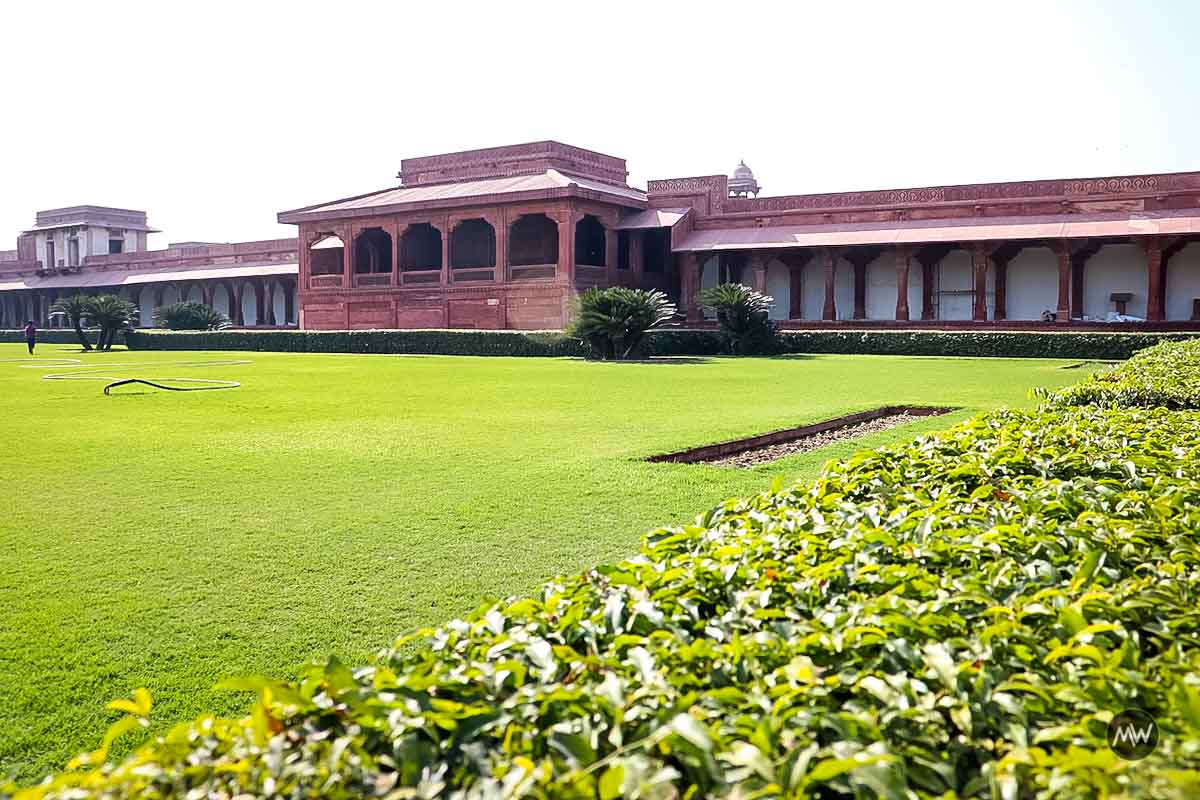
Well, this is the place where Akbar used to listen to the complaint of the general public without any discrimination and take the right decision. This is really spacious place with a big garden in front of it. Perhaps people used to sit in this garden.
Museum, Factory, and Naubatkhana
After exiting from the Diwan-e-Aam, you can reach the museum by walking a few steps and the factory, which is located right in front of the exit, would have been used at those times.
Many old coins, weapons, sculpture relics, utensils, coins, inscriptions, etc. are stored in the museum.
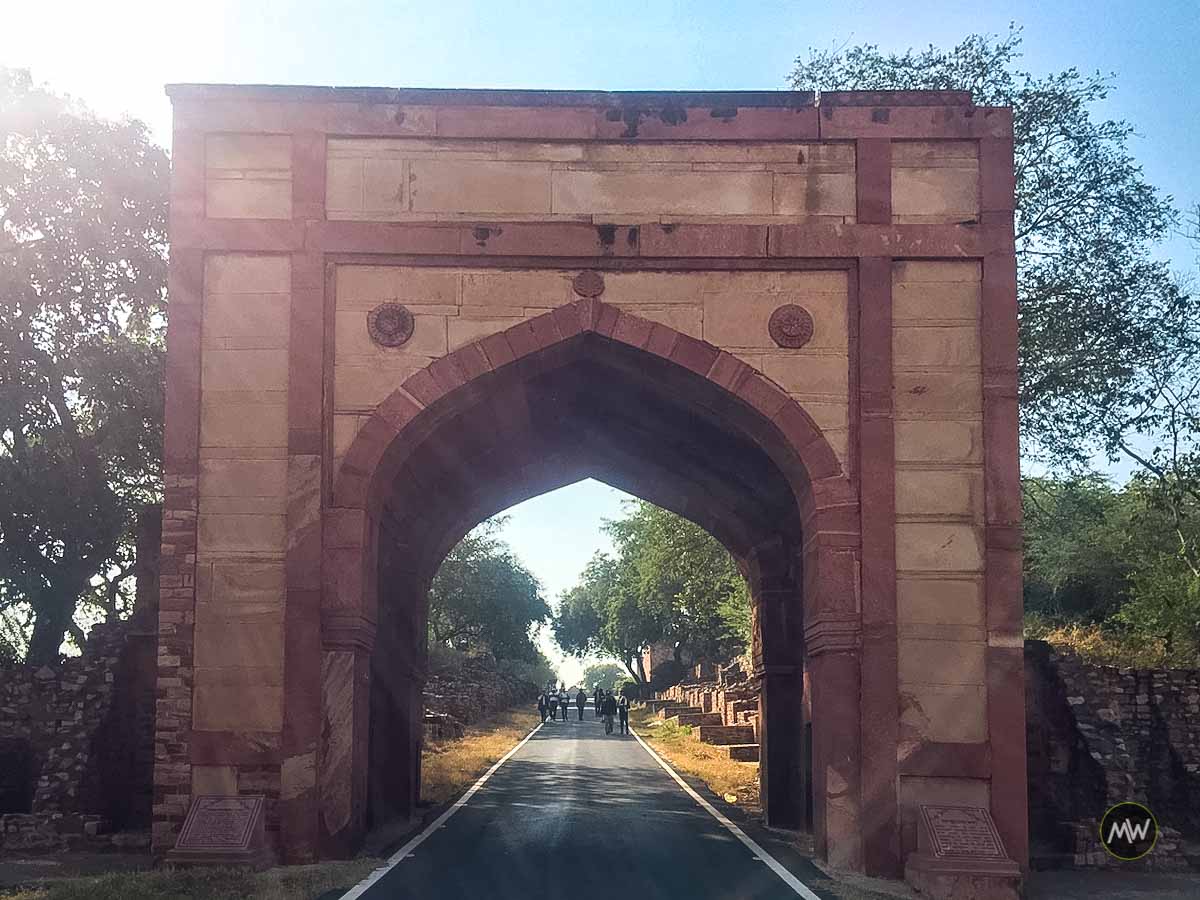
The Naubatkhana is normally the gateway where two soldiers are always stationed. Whenever the Mughal emperor Akbar entered the palace, they used to announce it by playing drums.
Practical Travel Tips
- There are two ways to enter, either you come from the Buland Darwaza side (close to the bus station) and enter from the ticket counter to go to Jodha Bai’s palace after exiting Badshahi gate. Second, you come from Agra Gate, which is on the right side as soon as you enter Fatehpur.
- If you are in a private vehicle, then the road to Agra Gate will be right and if you are coming by bus, then the Buland Darwaza way is easy.
- Wear comfortable shoes and bring a water bottle as well because you have to walk a lot.
- If you want to get a guide, then take the guides posted by the Archaeological Survey of India from the ticket counter, and if possible, try to negotiate.
- Take special care of your pockets and belongings. While going inside the Dargah of Sheikh Salim Chishti, put a handkerchief or cloth over your head.
- Photography inside Salim Chishti Saheb’s tomb is not allowed, elsewhere you are free to do it. There is no extra charge for this.
- The physical ticket is not being given from the counter in view of the COVID-19. You have to scan a barcode near the ticket counter and take the ticket after online payment.
Ticket Rate and Timings
| Timings | Sunrise to sunset |
| Cost | Indian tourists, tourists from SAARC country: ₹ 35 (+5 per person, tax to be paid). Foreign tourists: ₹ 550 Admission for children under 15 is free. |
Note: If you wish, you can book tickets for all places in Agra and Fatehpur Sikri via an app named Monuments of Agra from Google Play Store.
How to reach?
Agra and Fatehpur Sikri are considered a Golden Triangle with Delhi and Jaipur. Hence reaching Fatehpur Sikri is very easy. The distance from Agra to Fatehpur Sikri is just 43 km. To get here, you can use the following methods.
By air
The nearest airport is Agra’s Kheria Airport but there are not many flying options as of now so it is better to either come via Jaipur Airport (200 km) or New Delhi Airport (250 km). One can take a bus, cab, or train from Delhi and Jaipur to reach Agra and then Fatehpur.
By rail
There are two main stations in Agra, Agra Fort Railway Station and Agra Cantt. Trains from both places operate from every corner of the country. There is also another station Tundla which is near Agra.
By road
The distance of Agra is 240 km from Delhi, 200 km from Jaipur, and 370 km from Lucknow. The main bus station is Idgah bus station, ISBT Agra, and power station bus stand. From Agra, you can take a bus, taxi or cab.
Conclusion
After some time Akbar had to leave Fatehpur Sikri. The main reason was the lack of water. This area was deserted due to a lack of a proper source of water.
Well, this journey has been more special and experienced than I thought it was. Seeing the places and things which we read about in the history books, was very pleasing and full of learning. While traveling we followed all the norms of COVID-19 and we request you to do the same.
Hope you like this article and I have been able to give all the necessary information. If I have missed anything or you want to express your views, then tell us in the comment box below. We are always ready to make every effort to improve ourselves further.
An appeal: Please do not throw garbage around. Use a dustbin and if you can’t find a dustbin, take the trash with you and throw it when you find one. Your small steps like this one can make the world clean and green.

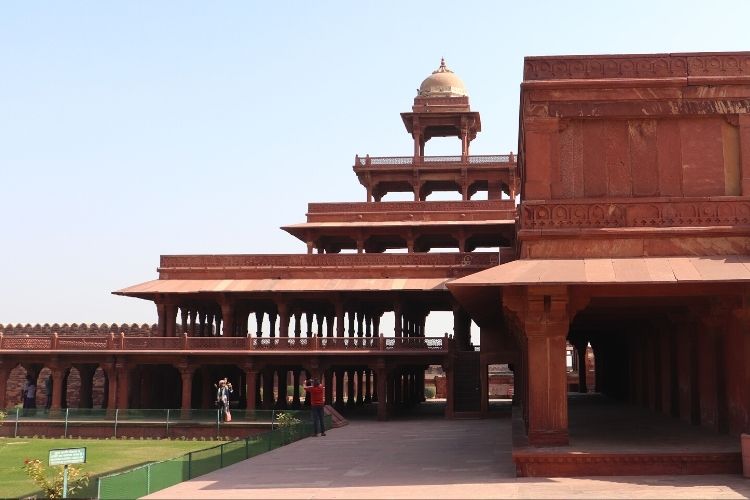
Very insightful. Thank you for the details, planning to go tomorrow.
We wish you have a great time tomorrow 🙂 Thanks, Abhinav.
FatehPur Sikri has always been on my travel radar but somehow never managed to visit it. Your photos make me really want to visit it badly…
It is indeed a place worth visiting. Next time you’re in Agra, you can plan your visit 🙂
Nice article. Very detailed description of each building.
Thanks, Bhavik! Glad you liked 🙂
Nice and Interesting Article. Keep Writing..!
Thanks, glad to hear you liked it.